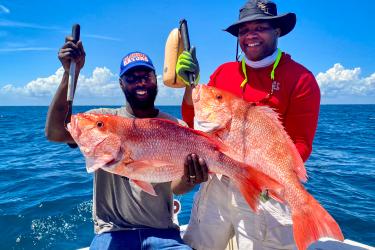During the heat of summer, many of us look forward to a refreshing swim in cooler water. However, if the water is too cold it becomes an unpleasant experience we can’t tolerate for long. Did you know that for sea turtles, cold water temperatures can also be fatal? Sudden cold snaps or intense, prolonged cold can be very dangerous for sea turtles, especially during the winter.
What is Cold Stunning?
Sea turtle are cold-blooded reptiles that depend on the temperature of their surroundings to maintain their body temperature. Sea turtles can normally control their body temperatures by moving between areas of water with different temperatures or basking in the sun at the water’s surface or on the beach. However, when temperatures rapidly decline and sea turtles are cut off from moving to warmer waters, they can suffer from a form of hypothermia we call cold stunning.

Authorized volunteers find a cold-stunned sea turtle on a Cape Cod beach and prepare it for transport. Credit: NOAA.
Cold stunning can be fatal as sea turtles become lethargic, experiencing decreased circulation and slowing of other body functions. Cold-stunned sea turtles are more likely to be hit by boats, eaten by predators, become sick, or die as their bodies shut down. Sea turtles are especially susceptible to cold stunning if water temperatures fall below 50 degrees Fahrenheit (10 degrees Celsius) or if they remain in shallow-water areas that can become very cold as air temperatures drop. This makes strong cold snaps and unseasonably cooler weather serious business for sea turtles.
Who Helps Cold-Stunned Sea Turtles?

Allen Foley, with Florida Fish and Wildlife Conservation Commission, approaches a cold-stunned sea turtle stranded on a beach. Credit: NOAA.
NOAA and our partners monitor water temperatures and mount rescues of cold-stunned turtles as we are able. Rescued cold-stunned turtles are taken to partner facilities to recuperate and are released back to warmer waters. We see annual cold stunning events in three primary areas of the United States, though cold stunning also occurs in many other locations around the U.S. and the world.
Massachusetts

In recent years, an average of 600 sea turtles have been found cold stunned along the Cape Cod Coast in Massachusetts from late October through December each year. In the winter of 2014-2015, 1243 sea turtles washed up on Cape beaches, of which 746 were alive. Local cold stunning response efforts are led by Mass Audubon’s Wellfleet Bay Wildlife Sanctuary.

Once collected and triaged, they go to the New England Aquarium’s Animal Care Center in Quincy for further assessments and treatment. As the facility fills up, the Aquarium transfers some sea turtles to rehabilitation facilities throughout the East and Gulf coasts. Recovery can take anywhere from a few months to several years, depending on the extent of the turtle’s injuries. When ready for release, sea turtles either are flown or driven to points south where the water is warmer. While many survive, we are also learning a great deal from those that don’t.

Florida
On the Gulf coast of Florida, cold stunning typically occurs in the panhandle area, primarily in St. Joseph Bay. This excellent habitat for green turtles has wide flats of sea grass for food, but it also has shallow water where water temperatures can drop quickly during cold periods. Cold stunning also regularly occurs on the Atlantic coast in the Indian River Lagoon complex. In January 2018, more than 1000 turtles, mainly juvenile greens, were rescued after becoming cold-stunned in St. Joseph Bay. The largest cold stunning event recorded in Florida occurred in 2010, with more than 4500 sea turtles rescued within the state. The Florida Fish and Wildlife Conservation Commission leads response efforts to stranded and cold stunned sea turtles in Florida.

Texas
Cold stunning occurs annually along the entire Texas coast. The majority of turtles are typically found in the Upper Laguna Madre and Corpus Christi Bay, which are excellent green turtle habitat.More than 3,500 sea turtles, primarily juvenile green turtles, were rescued between December 2017 and January 2018 in the largest cold stunning event ever recorded in Texas. The National Park Service leads response efforts to stranded and cold stunned sea turtles in Texas.
How Can I Help?
When the weather in your area gets chilly, or a strong cold front comes through, remember to:
- Keep an eye out for cold stunned sea turtles on beaches and shorelines
- Slow down if traveling by boat
- Report stranded or injured sea turtles to your local sea turtle stranding networks

Rehabilitated sea turtles are loaded into tubs on U.S. Coast Guard vessel for offshore release. Credit: NOAA.



